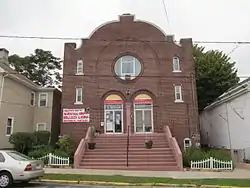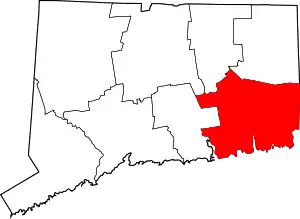Ohev Sholem Synagogue (New London, Connecticut)
The Ohev Sholem Synagogue is a historic synagogue building at 109 Blinman Street in New London, Connecticut. Built in 1920, good example of the Classical Revival and Colonial Revival style applied to synagogue architecture. The building served a religious function until 1974, when it was sold to a Latino community organization. The building was listed on the National Register of Historic Places in 1995 for its architectural significance.[1][2]
Ohev Sholem Synagogue | |
 Ohev Sholem Synagogue | |
  | |
| Location | 109 Blinman St., New London, Connecticut |
|---|---|
| Coordinates | 41°21′4″N 72°6′9″W |
| Area | less than one acre |
| Built | c. 1920 |
| Architectural style | Classical Revival, Colonial Revival |
| MPS | Historic Synagogues of Connecticut MPS |
| NRHP reference No. | 95000562[1] |
| Added to NRHP | May 11, 1995 |
Description and history
Ohev Sholem is located west of New London's main business district, on the north side of Blinman Street between Truman and Bank Streets. It is a two-story masonry building, built out of red brick mostly laid in Flemish bond. Its entry has double doors separated by an engaged column, set in round-arch openings. A large circular window stands above the doors, within a large brick archway that encompasses it and the doors. Four small windows flank this arch, two on each side. The facade is crowned by a stepped segmental arch with short flanking posts. The interior has a vestibule area, with stairs leading up to a former gallery (now offices), with the main sanctuary including what appears to be an original chandelier, and a recess in which the ark housing the Torah would have been placed.[3]
The Ohev Sholem congregation appears to have had its organizational original in a community support organization in which local Jews cared for their ill and infirm. That organization purchased the land on which the temple stands in 1916, but the congregation does not appear to have been officially organized until at least 1920, by which time the building was likely standing. The building is architecturally significant within the state for its distinctive combination of Classical Revival, Colonial Revival, and Romanesque features. The congregation was merged with another in 1974, at which time the building was sold to La Centro de Comunidad, a Latino community organization. It is likely that certain trappings of Judaism (such as a probably Star of David in the circular window on the facade) have been removed from the building.[3]
See also
- Agudath Sholem Synagogue, Stamford, listed on the NRHP in Fairfield County, Connecticut
- Ahavas Sholem Synagogue, New Haven, listed on the NRHP in New Haven County, Connecticut
- National Register of Historic Places listings in New London County, Connecticut
References
- "National Register Information System". National Register of Historic Places. National Park Service. March 13, 2009.
- David F. Ransom (August 26, 1994). "National Register of Historic Places Registration, Multiple Property Listing, Historic Synagogues of Connecticut: Ohev Sholem (Ohave Cholum) Synagogue / Centro De-La-Comunidad". National Park Service. (pages 94-101) and Accompanying two photos, one exterior and one interior (apparently from 1994?)
- "NRHP nomination for Ohev Sholem Synagogue". National Park Service. Retrieved 2015-01-30.
